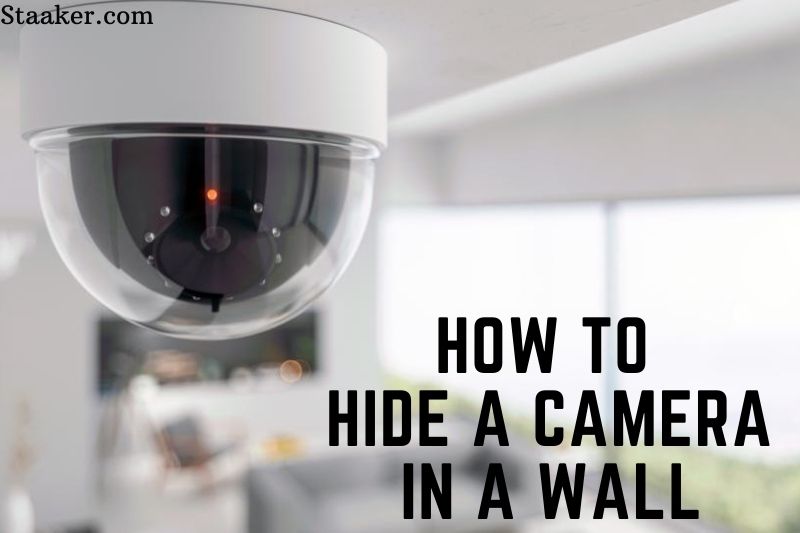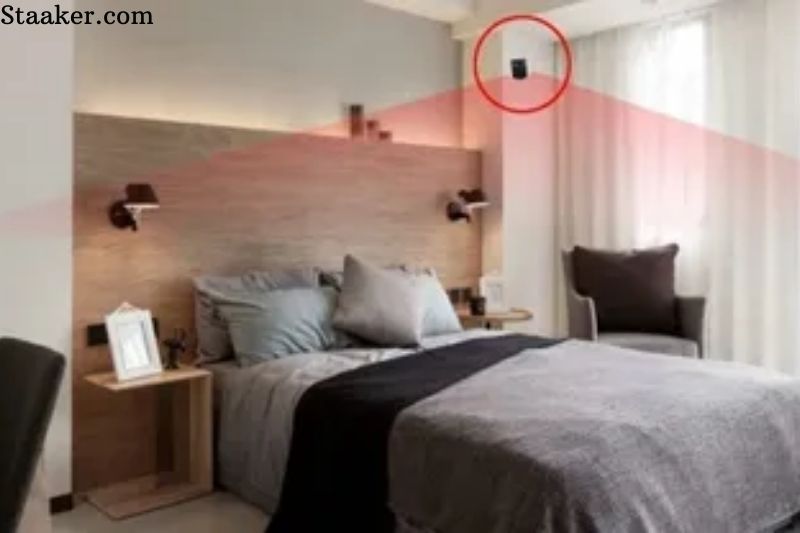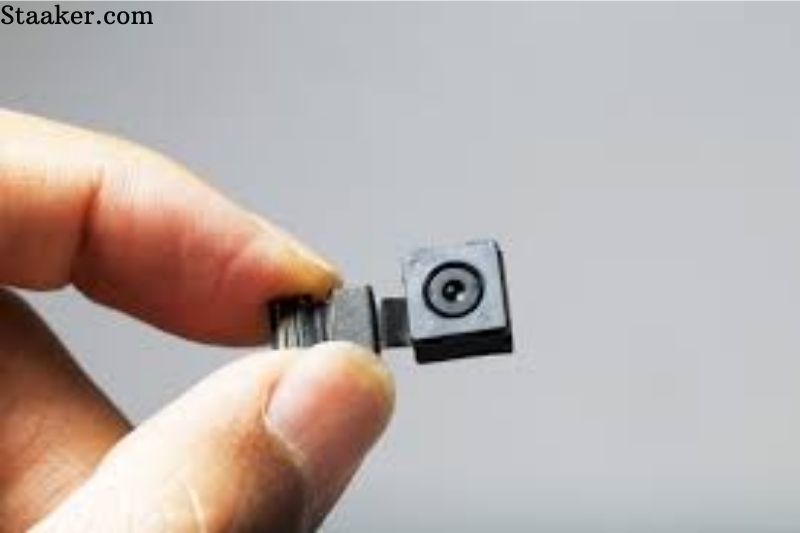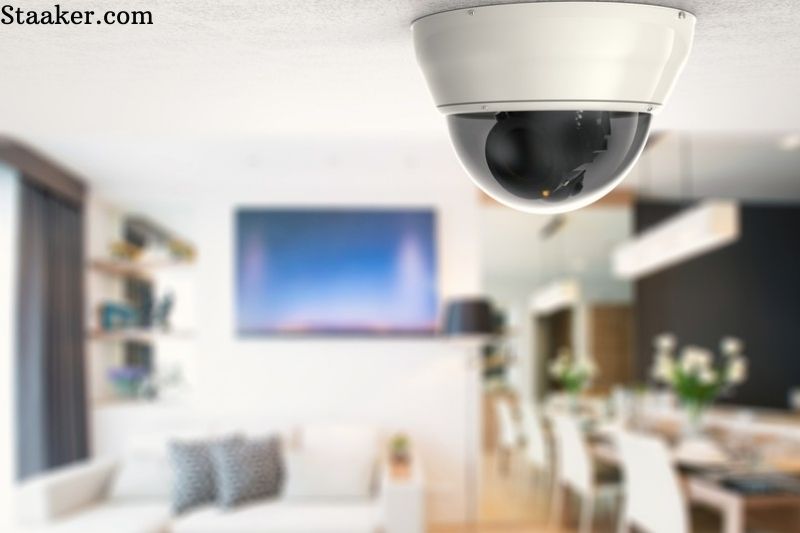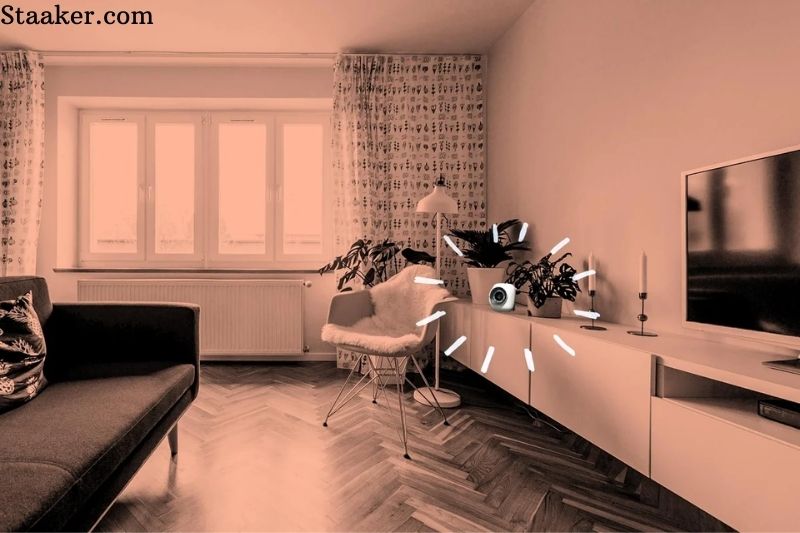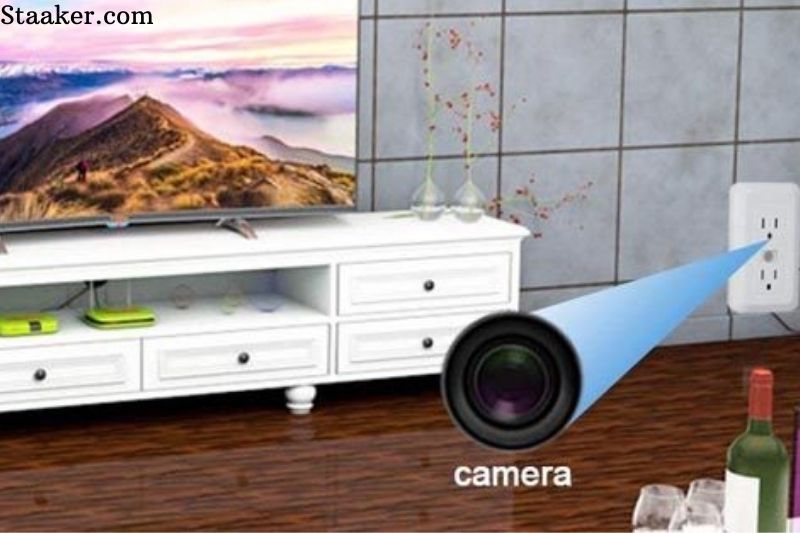To many people, hiding a camera may seem like something out of a spy movie. However, there are many reasons why you might want to hide a camera on a wall. Maybe you want to keep an eye on your kids while they’re home alone, or perhaps you want to monitor activity in a particular area of your home.
Whatever the reason, it’s not that difficult to hide a camera in a wall. Here are a few tips on how to hide a camera in a wall.
Reasons For Installing Hidden Security Systems
Let’s look at some of why a hidden security system is helpful before learning how to hide a camera in a wall.
Security mechanisms that are hidden are not vulnerable to tampering. Burglars may easily deactivate some security cameras, and the most conspicuous ones will be their first target.
Hidden systems do not detract from the aesthetics of your home, and guests will feel safe knowing they are not being observed.
Hidden cameras are more effective at keeping tabs on the activities of other persons in the house, particularly nannies who are responsible for the welfare of your children.
Note: The majority of households and businesses have a mix of hidden and visible surveillance devices.
Tips On Hiding Security Cameras Indoors
The best technique to conceal a security camera is to mix it with the environment. Here are some suggestions for concealing a security camera inside:
WALL
Finding materials that will allow your camera to blend in with the wall is the most excellent approach to learning how to hide a camera in a wall.
A bulky picture frame or a painting – place it behind a sturdy artwork, preferably inexpensive, and poke a hole in a dark print to allow the lens to blend in. The painting or picture frame should ideally have a 3D effect to place a small camera behind it.
A bookcase – Because bookcases are cluttered, they’re one of the finest places to hide your device It might be hidden inside a hollow book seen in gift shops or one of the bookshelf ornaments.
Wall clock: If the design allows it, you can also place a small camera on your wall clock. It should be very subtle because people stare at the clock all the time, and an odd device attached to it can draw unwanted attention. There are so many ways to learn how to hide a camera in a wall that you won’t even need to drill anything.
LIVING ROOM
There are various areas in a living room where a camera might be hidden, but the idea is to blend it with the environment rather than keeping it hidden.
Lamps and other light fixtures — If your living room has a standing lamp, you may place a small camera inside it to capture a decent angle around the room.
Tissue box – Some people place small cameras inside tissue boxes to blend in with the surroundings. The obvious disadvantage is that it might be easily tampered with by guests or youngsters reaching for tissue without realizing it.
OUTDOORS
When concealing a security device outside, you can encase it and wrap or cover it in a material to make it blend in with the surroundings.
Bird House – To catch unwitting trespassers, build a little birdhouse and attach a camera inside.
Tree – Hide an exterior camera in a bush or a tree, ideally one close to the driveway, so you can easily record license plates.
NOTE: Before installing your surveillance systems, we urge that you verify state and federal legislation to ensure that you are not breaking any laws.
How to Install a Hidden Camera
Part 1: Choosing a Location
1. Ensure the camera has a clear line of sight to anything it’s watching. The most crucial aspect of installing any concealed camera is determining the best location. The first step is to consider where the person or behavior you’re watching is most likely to occur. Make sure it is pointed directly at this location with no visual impediments.
- If you were concerned about someone breaking into your house while you were gone, you could install cameras near your doors and windows.
- If you suspect your partner of cheating on you, you might position a camera in front of your bed or the passenger seat of your lover’s vehicle.
- You would point the camera toward your child’s crib if you were concerned about how a nanny was treating your youngster.
- If you want to feed the neighborhood cats, make sure there aren’t any other animals around the food dish that you don’t want to feed. If you reside where passers-by might view device, you should hide it to avoid theft. You’d keep your camera hidden and point toward the food in this situation.
2. Think about the sound quality. If you want to record crisp, clear sound, you’ll need to situate your camera in a location that allows for audio recording. Make sure it’s as near where you imagine the speaker will be. It should not be placed near anything loud, such as a television or radio, as this may drown out or make it difficult to understand the speaker.
- Installing a camera in a room with a television, for example, should be done on the opposite side of the room.
- Set up it near a couch or chair where your target is most likely to sit.
- Place your camera away from the car’s speakers while placing it in a vehicle.
3. If necessary, place the camera near its external power supply. While many current hidden cameras run on batteries, others require an external power source and may need to be plugged into a wall socket. If your camera requires this power, set it near an electrical outlet. The plug and wires will have to be concealed or disguised as a common household item.
4. If possible, connect your camera to a network. Some hidden cameras have internal storage, while others transmit video over a network connection, while still others offer both.
- If your camera connects to a network via an Ethernet or USB cable, it should be well-hidden and kept out of sight. Keep such a camera near the computer or router to which it is connected.
- The majority of commercial nanny cam models are wireless. If you buy a camera like this, make sure it can connect to a secure wireless network.
5. Examine whether the eye is naturally pulled to the location. Specific designs will draw more notice than others. Avoid any areas where your target is likely to stare at you directly.
- Maintain a significant difference in eye level between your camera and the average person.
- Request that someone is looking for a camera you’ve installed in a specific room. If they can’t discover it despite knowing it’s there, an unknowing person is even less likely to notice it. If they rapidly locate the camera, try again in a new location.
- Inside an air vent, within a fake smoke alarm, or behind furniture are some examples of suitable hiding areas that people would not think to look.
- Any location near paintings, light switches, or television sets is an example of possibly terrible concealing areas where the eye is quickly drawn.
6. Protect your camera from the weather. Make sure any outside security cameras are weatherproof and installed in a way that prevents such damage from occurring in the first place. Ideally, you should get a camera intended exclusively for outside use. Store it in a sunroom or screened patio if you don’t have one.
Part 2: Installation
1. Double-check your lighting. Many hidden cameras need intense light to function correctly. At the same time, when such light is projected directly into their lenses, they cannot record images. Face your camera away from bright sources of light. Make sure anything you’re trying to film is well-lit at the time of day when it’ll be most visible.
2. Ensure that your camera is hidden. A hidden camera is useless if your target is aware of its presence. There are two main techniques for keeping hidden cameras hidden:
- Reduce the size and visibility of the camera. In other words, a camera with a small visible lens that is hidden in plain sight. When most people think of concealed cameras, this comes to mind. Because a successfully hidden camera must have an unobstructed view of the person it is viewing, this form of disguise is considerably easier to notice. The individual can see the lens if the lens can see them.
- Make it look like a commonplace item. Commercial nanny cams that mix smoothly into the home surroundings include tissue boxes, coffee makers, alarm clocks, digital picture frames, wall hooks, and even plug-in air fresheners. Compared to a different camera that has merely been disguised, a lens made to look like a button is considerably less likely to be noticed.
3. Follow any suitable commercial camera installation instructions. There are hundreds of concealed cameras available on the market, each with its own set of installation instructions.
- If you bought your camera secondhand, seek the model number on the internet. Many electronic equipment user manuals are accessible for free download.
- Remember to install any required applications. The majority of hidden cameras rely on third-party software to operate. This could be a program that came with your camera or one that you downloaded from the internet. Some programs are even designed to be put on your smartphone to keep an eye on things while you’re on the road.
4. Check out your camera. It’s critical to test the functionality of your device, mainly if its motion or sound is actuated. It’s good to make sure your camera turns on when the correct stimulus is applied. The method you use will vary widely depending on your camera and any accompanying software.
- First, wave your hand in front of the camera to see if it records anything. Check your computer’s internal storage or the camera to determine if this motion was captured.
- Try simulating a real-life event, such as entering a room, to verify if the camera captures your activities with adequate image quality.
- To guarantee that it continues to work, test it again in a few hours and a few days afterward.
5. Keep track of your covert camera. Even though the setup was simple, you’ll need to perform routine maintenance to ensure your camera continues to function.
- If batteries power your camera, you’ll need to replace them or recharge the gadget. Consult the owner’s manual for recommendations on how often to perform this. If no suggestions are given, keep track of how quickly the battery discharges.
- Clean the camera’s memory regularly. You should review and discard footage frequently on cameras with little internal storage. You may never need to do this if your camera is connected to a server with a large storage capacity.
- Your camera, like other gadgets, may break or wear down without you realizing it. Make that your camera is still operational regularly.
Part 3: Making a Hidden Camera
1. Confirm that hidden cameras are legal. Hidden cameras are often against the law. However, the actual regulations change between countries and even states. Before you install any concealed cameras, make sure you know the rules in your area.
- As a general rule, it’s lawful to install concealed cameras on your land as long as they’re on your property and there’s no reasonable expectation of privacy. Installing it in your living room or car, for example, usually is lawful. Even if you own the house, cameras in spaces where privacy is expected, such as a restroom or a spare room you rent out, are often not authorized.
- Audio recording laws are frequently different and more stringent than visual recording laws. In the United States, 38 states allow for the secret recording of conversations if at least one person agrees. In contrast, the remaining 12 states prohibit recording unless all parties are aware and agree.
- Hidden cameras in the workplace are usually only legal if the employees are notified that they will be filmed.
- In the United Kingdom, special permission is granted for mounting cameras outside one’s home in circumstances of suspected elder abuse.
2. Select a camera that fits your requirements. While all concealed cameras essentially perform the same thing (offer covert monitoring), knowing your needs is critical in determining the sort of camera you should place.
- Do you need to be able to recognize the folks you’re recording? If you wish to catch an otherwise unknown thief, you’ll need a camera that can capture either video or still images with a high resolution.
- Are you looking for specific acts in a known person? Then it would help if you looked for a camera that can capture motion well. Purchase a camera that records video at a greater frame rate (fps). Avoid cameras that solely shoot still photographs. In this instance, lower resolutions are acceptable.
- What are the lighting conditions of the object you want to study? Consider acquiring an infrared camera if you plan on recording trespassers at night.
3. Purchase the appropriate hidden camera model. Hundreds of various hidden cameras are available on the market. They range in price from high-tech devices marketed by surveillance professionals that can record high-resolution or infrared video to low-cost low-resolution cameras found in most electronics stores.
Part 4: Making a Hidden Camera
1. Gather your resources. An old webcam, an electronics tool kit, a hot glue gun, and an unobtrusive enclosure are required. The housing should be something you can safely disassemble, and that will look good with a wire attached to it. A power source, a coffee maker, or an old alarm clock are all choices.
- Because you’ll be connecting this to a computer, you’ll also need a personal desktop or laptop. If you have a tablet that is USB compatible, you can use it.
- Making your hidden camera isn’t the most practical option now that cheap nanny cams are widely available. However, if you have these ingredients on hand, it has the advantage of being free.
2. Disassemble the webcam. Remove the original housing of your webcam with caution using your electronics tool kit. All components except the camera’s lens, circuit board, and USB cord should be removed.
- Make sure the lens and USB cable are not disconnected from the circuit board. Keep all of these parts together.
3. Hollow out your living quarters. You’ll need to make room for your camera to fit inside unless you’re utilizing an already hollow object. Remove some or all of the contents from the housing using any appropriate equipment.
4. Check that the lens and USB cable have holes in the housing. For example, if you’re using an electric pencil sharpener, the object already has two perfect apertures built-in. If not, you’ll probably have to drill the holes yourself with a suitable cutting bit. Ensure that the cable hole is located at the seam where the housing opens.
- When drilling a new hole, think about where it will be hidden. Choose a relatively dark section of your object so that the lens blends in better.
5. Place your webcam inside its housing and secure it. Attach your camera and circuit board to the inside of the enclosure with your hot glue gun. Adhesive the circuit board to the bottom or side of the housing, sandwiching it between the solder side and the glue. Place the camera so that the lens is flush with one of the holes. Make sure that no glue gets on the camera lens.
6. Assemble the housing again. Before closing the housing, place the USB cable in the opening. If necessary, add extra hot glue. Make sure the object looks the same as before and that any evidence of tampering is hidden. Cover the cable with a strategically placed book or piece of paper.
7. Make sure your camera is connected to your computer. Connect your new hidden camera to a computer using the USB cord and the computer’s USB port. Connect the cable to a USB extension if it’s too short. Install your preferred webcam spy software and verify that your camera is operational.
- Waving your hand in front of your camera is an excellent to test it. Is your hand visible on the computer screen? Did the software capture that action? If this is the case, consider leaving the room for a time and then returning. Was your arrival captured on camera? If that’s the case, you’ve constructed your own concealed camera.
Where To Look For A Hidden Camera
The next step is to learn how to identify hidden cameras in a hotel or your own home now that you know how to hide a camera in a wall and set up your surveillance system. This may sound like an adventure, but it is a fantastic approach to safeguarding your privacy.
- Tip #1: Be aware of your surroundings and be cautious of items. Double-check these objects for a hidden camera, whether it’s the spacing in the wall that’s a little wrong or a single book poking out slightly.
- Tip #2: Turn off all of the lights in your room and search with a phone flashlight. This is an excellent approach to spotting a hidden camera because most camera lenses reflect light.
- Tip #3: To discover hidden cameras, use a professional spy-camera finding device. You might think this is excessive, but this step is crucial. This is something to consider if you travel frequently and bring critical information.
Here Are Some Other Considerations
It would be best if you use caution when using a covert camera.
The purpose is to prevent wrongdoing by capturing the perpetrator and having proof — not by invading people’s privacy.
When considering where and why to hide a camera, you must keep this in mind.
Make sure you understand why you’re doing it and not going too far.
It would help if you thought twice about revealing any footage or photographs to the public without first considering the repercussions.
Aside from privacy, there are a few more considerations to make if you want the most outstanding results:
- The amount of information you obtain depends on the quality of your camera; if you want to get their faces, you’ll need a higher-quality camera.
- You may be compelled by law to post a sign informing visitors that there are concealed cameras on the premises – do your homework.
- Consider the camera’s view angle and coverage area. Is it a swivel chair, and what is the angle of set view?
- It’s OK to seek professional assistance. This will cost more money, but it is the only way to ensure correctly the task is done.
Maybe you need to see:
- How To Make Your Camera Quality Better
- How To Set Up Blink Camera
- How To Block Neighbors Security Camera
Conclusion
In conclusion, hiding a camera in a wall is not as difficult as it may seem. There are a few tips on how to do it successfully, and if you’re careful, you can keep an eye on your loved ones without them knowing. Thank you for reading. Staaker.com hopes this article was helpful.

